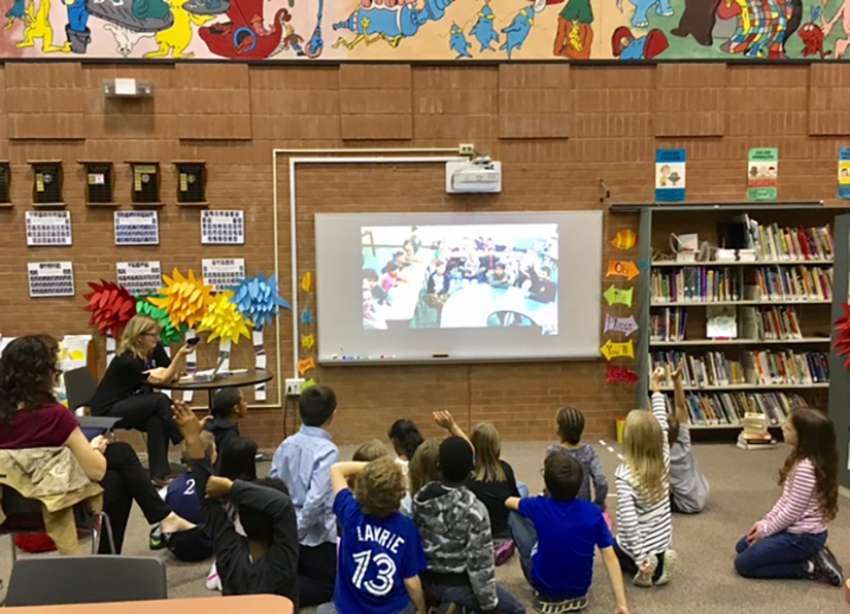Grade 3 students at Whitby, Ont.’s St. Theresa Catholic School connect with a class at Marjorie Mills Public School in Longlac, Ont., 1,000 km away, through Skype. Teachers from the two schools are using the video chat application to connect the communities and give students the opportunity to learn about each other.
Photo courtesy of St. Theresa’s Catholic School
Learning program unites student pen-pals 1,000 km apart
By Meggie Hoegler, The Catholic Register
When a state of emergency was declared in April 2016 by the Attawapiskat First Nations in northern Ontario after a drastic increase in suicide attempts, a couple of teachers a thousand kilometres away felt a call to action.
Loretta Traynor and Patriza Bortoluzzi, both Grade 3 teachers at St. Theresa Catholic School in Whitby, Ont., used grant money from the province’s Teacher Leadership and Learning program to build a unique long-distance relationship via the video chat application Skype.
“We had the idea of reaching out via a tech-based platform to form a pen-pal relationship between our students and students from a northern community,” said Traynor. “It was a perfect fit, too, as the Grade 3 social studies curriculum focuses on learning about the different parts of Ontario.”
As a first step, Traynor and Bortoluzzi contacted Grade 3 teacher Lisa Adams at Marjorie Mills Public School in Longlac, Ont., 305 km north of Thunder Bay. A few weeks later, Adams was flying to Toronto to meet them.
“They were looking for a school from the north with a high Indigenous population to join their project in a virtual classroom to learn about social studies,” said Adams. “It gives us an amazing opportunity to share the wealth of knowledge that our students have with others who don’t have the same access.”
When Skyping each other, the teachers project the screen so the entire classroom can see and be seen. The students also use Padlet, an app that acts as a virtual bulletin board where both schools can post questions, answers and photos. The lessons are based on questions the students have for each other.
“It snowed here the other day and it wasn’t snowing in Toronto,” said Adams. “We took advantage of that opportunity in the moment; we don’t want it to be too rigid. We want the kids to wonder and ask about each other.”
There is a lot to learn on both sides, even considering the geography. Longlac has a population of 1,383. Eighty-five per cent of the student population at Marjorie Mills self-identify as Indigenous. Of Whitby’s 128,377 population, only one per cent identify as Indigenous. Seventeen per cent, however, belong to other visible minorities.
Adams, a self-proclaimed northern girl, began her teaching career in the First Nations community of Nibinamik (Summer Beaver) located 500 km north of Thunder Bay. This is her fifth year teaching in Longlac.
“I want them (students) to see the value in themselves and take pride in the uniqueness of who they are,” said Adams. “I also want them to gain some knowledge about other parts of Ontario. The students in Whitby have a very culturally diverse classroom. I want my students to learn about those cultures as well.”
Bortoluzzi calls it a 50/50 partnership where both classrooms can learn from each other.
“One of the students asked what languages we speak here,” said Bortoluzzi. “We have students who speak Polish, Russian and Filipino. They said ‘We speak Ojibway,’ and one of our students asked ‘What is Ojibway?’
“Starting these cultural conversations is what we are hoping for. They are a little more homogenous up there. We want to give them a language and vocabulary to get to know one another on a deeper level than just ‘what is your favourite animal?’ ”
But kids will be kids. The children were curious to hear about what the other school’s playground looked like and what their favourite food, animal and colours were.
Please support The Catholic Register
Unlike many media companies, The Catholic Register has never charged readers for access to the news and information on our website. We want to keep our award-winning journalism as widely available as possible. But we need your help.
For more than 125 years, The Register has been a trusted source of faith-based journalism. By making even a small donation you help ensure our future as an important voice in the Catholic Church. If you support the mission of Catholic journalism, please donate today. Thank you.
DONATE

